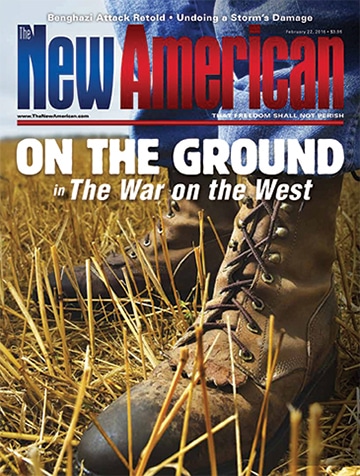The Federal Bootprint
In crafting a constitution to create a central, federal government, the American Founding Fathers were careful to strictly shackle it so that this proposed new entity would stay within its defined, delegated powers, so that it would not be able to overawe or overwhelm the individual states that were to be its sovereign masters in all powers not expressly transferred to the national government. Those delegated powers are enumerated, most particularly, in Article 1, Section 8 of our U.S. Constitution. One of the most important features of this section is the limitation on the federal government’s ownership of land.
According to the Constitution, our law of the land, “The Congress shall have Power … To exercise exclusive Legislation in all Cases whatsoever, over such District (not exceeding ten Miles square) as may, by Cession of particular States, and the Acceptance of Congress, become the Seat of the Government of the United States, and to exercise like Authority over all Places purchased by the Consent of the Legislature of the State in which the Same shall be, for the Erection of Forts, Magazines, Arsenals, dock-Yards, and other needful Buildings.”
The federal government was allowed to have a 10-mile square (100 square miles) for a seat of government. Property for “Forts, Magazines, Arsenals,” etc., for national defense purposes, could be purchased from the states if the state legislatures consented. That’s it. Under Article IV, the federal government is allowed to acquire new territory, which is to be “disposed” of by turning it over to the new state government when the territory is admitted into statehood. Newly created states are to be admitted on an “equal footing” with the original 13 states, meaning with full sovereignty over their lands, not with a distant federal landlord controlling 30 percent, 50 percent, or 90 percent of their land and resources. As The New American explained in some detail in a May 2014 article, “Feds vs. the West,” virtually all of the states that were admitted to the Union after the original 13 found that they had to fight in Congress and the courts to get the federal government to relinquish its hold on their lands. Citizens of the 12 western states (Alaska, Washington, Nevada, Utah, Oregon, Idaho, Arizona, California, Wyoming, New Mexico, Montana, and Colorado) are now trying to do the same thing, to obtain their long-delayed “equal footing” and evict the unconstitutionally created federal bureaucracies (BLM, Forest Service, Fish & Wildlife Service, etc.) from their land so that they can manage their own affairs the same as the other states do.
JBS Member or ShopJBS.org Customer?
Sign in with your ShopJBS.org account username and password or use that login to subscribe.

 Subscribe Now
Subscribe Now
- 24 Issues Per Year
- Digital Edition Access
- Exclusive Subscriber Content
- Audio provided for all articles
- Unlimited access to past issues
- Cancel anytime.
- Renews automatically

 Subscribe Now
Subscribe Now
- 24 Issues Per Year
- Print edition delivery (USA)
*Available Outside USA - Digital Edition Access
- Exclusive Subscriber Content
- Audio provided for all articles
- Unlimited access to past issues
- Cancel anytime.
- Renews automatically


